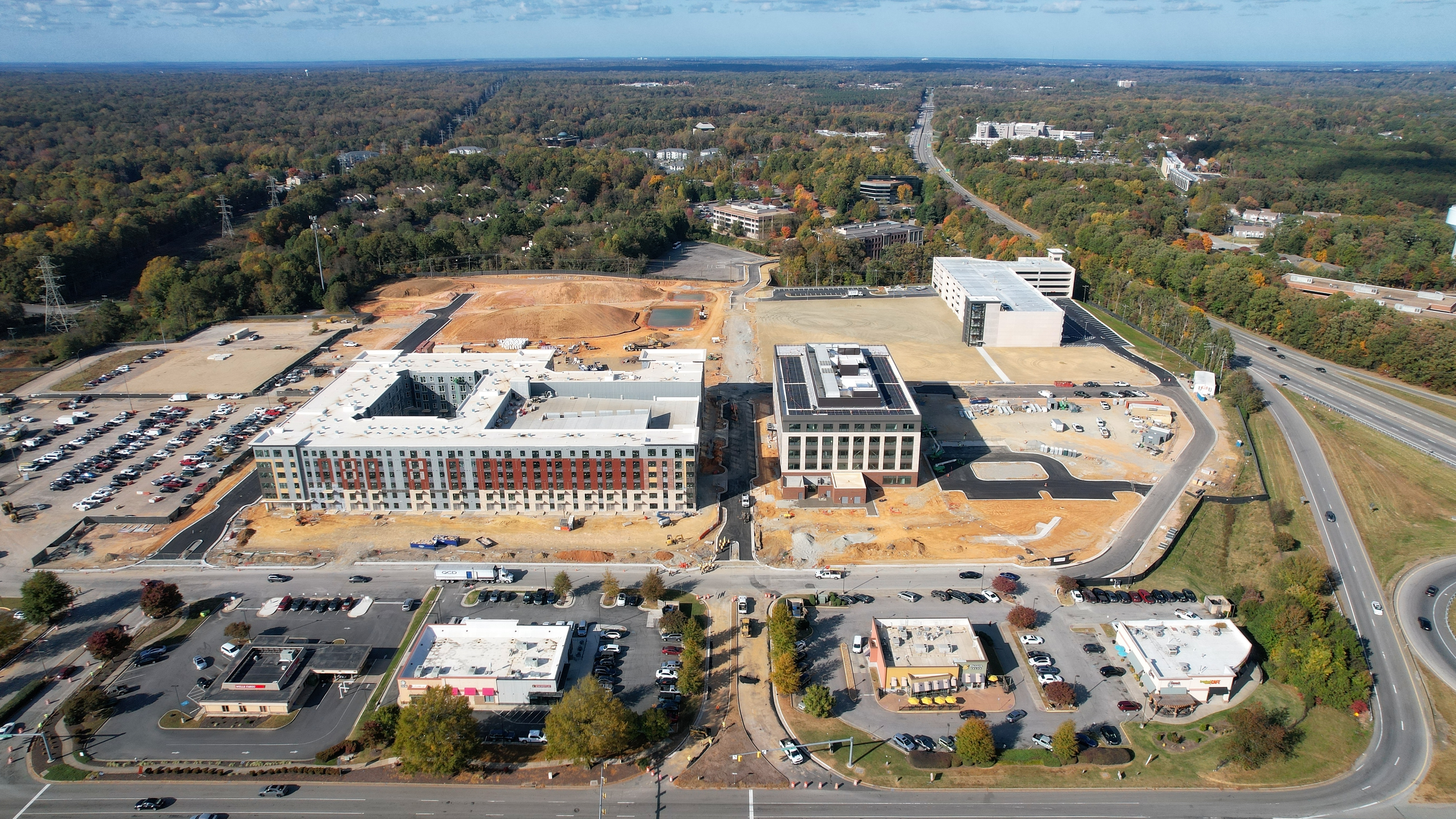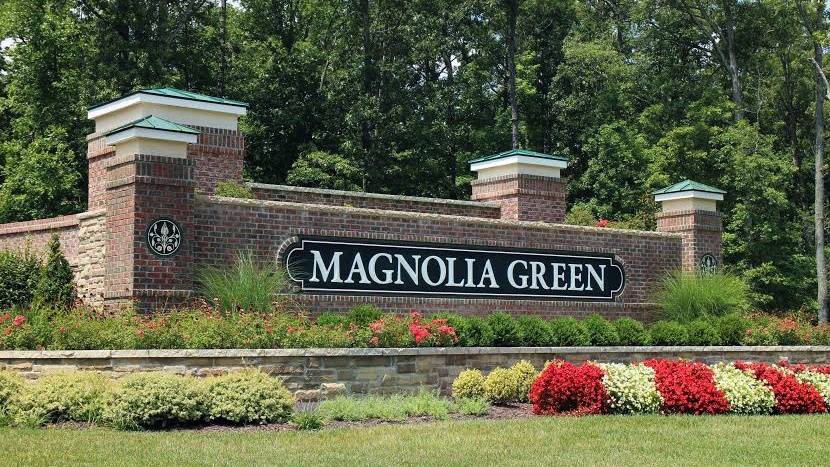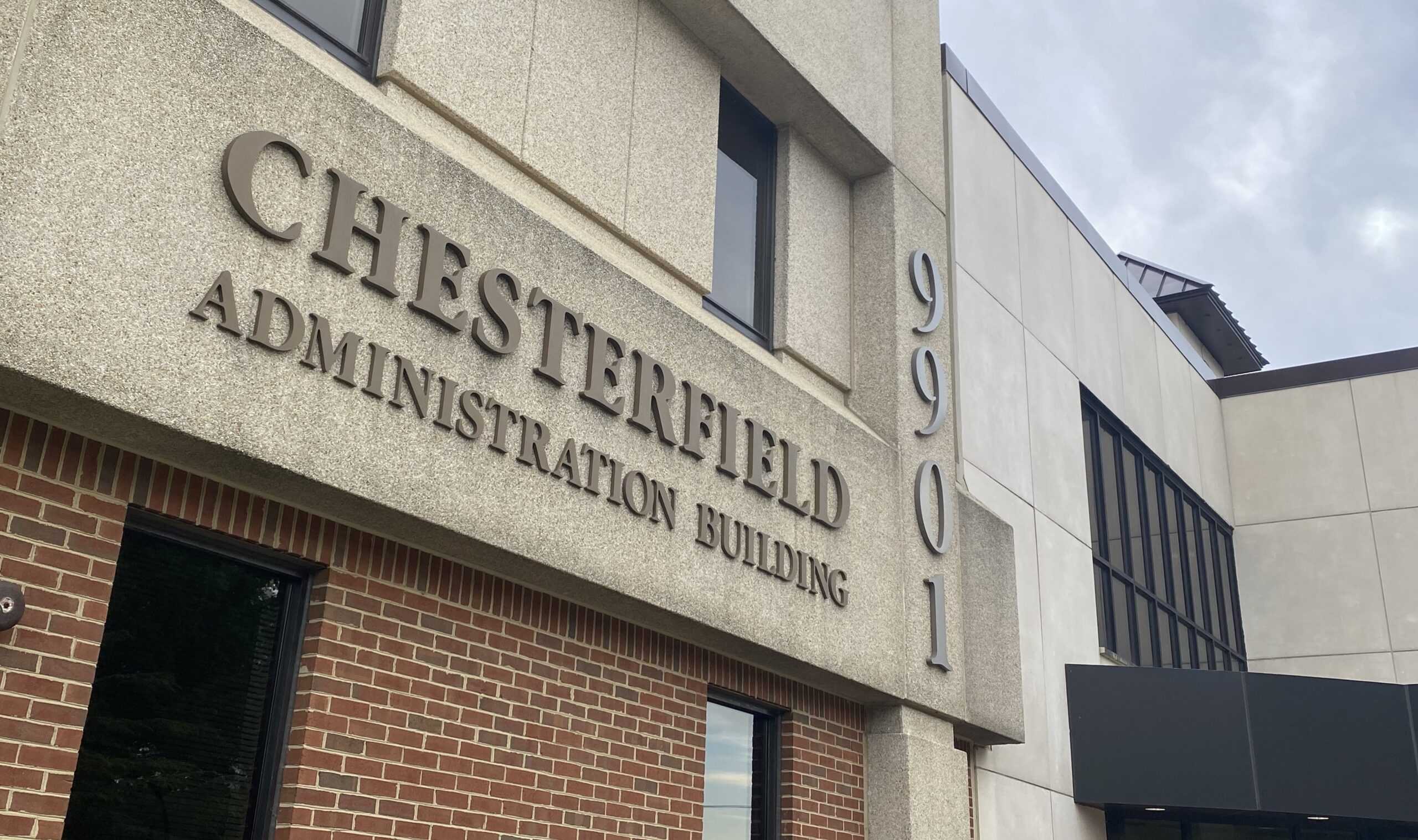
Chesterfield has released its latest draft of a proposed zoning ordinance update, which would include new zoning districts and other changes. Pictured is the Springline at District 60 project in late 2024. (BizSense file photos)
Chesterfield officials continue to tinker with an extensive update to the county’s land-use rules, ahead of plans to adopt a new zoning ordinance this year.
The Zoning Ordinance Modernization Project (ZOMod) is several years in the making and would revamp the county’s zoning ordinance, which specifies which land uses are permitted where and under what circumstances. The project would decrease the current number of zoning districts and add new designations.
The zoning ordinance draft released last month retains the conditional use planned development (CUPD) process, in a reversal of the previous draft that proposed its elimination. Also proposed are lowered lot size minimums in residential districts, among other tweaks.
CUPD returns
The third ZOMod draft features a return of the CUPD process in response to concerns from the Planning Commission about nixing what’s been a popular approach to zoning in the county, Assistant Planning Director Steven Haasch said.
“Because we use CUPD so much in this county, there’s a real reluctance to do away with it completely,” he said.
The CUPD process essentially allows for the creation of a customized land-use district for any project that doesn’t fit the ordinance. The tool has become popular in recent years as a workaround for Chesterfield’s aging zoning ordinance, which has fallen behind development trends, said Thomas Jenkins, the county’s zoning administrator.
“It’s almost impossible to do modern trends of development without going through that process. Any multifamily building built in the last few years has an automatic four or five exceptions,” Jenkins said.
Issues also crop up with subdivision lot sizes and the creation of mixed-use projects, which have to go through the CUPD process to allow a combination of residential and commercial uses.
About 20% of Chesterfield’s 424 square miles are subject to CUPDs and conditional-use permits. Given their custom nature, they present a bureaucratic challenge for county staff to keep up with what’s allowed on the property.
“Each one is different. So you can imagine a citizen calling us and saying what are my setbacks? What am I allowed to do on my property? Well, if you’re in a CUPD, it depends,” Haasch said.
County officials hope to see the CUPD only in special situations moving forward. Haasch said the county plans to guide developers toward an upcoming package of new districts to facilitate projects.
New zoning districts

Though all properties in Chesterfield would see their current zoning designations converted to comparable districts with the new zoning ordinance’s adoption, officials said the terms of previous zoning agreements would carry over.
The new zoning ordinance would feature 14 land-use districts, a reduction from the current 24 districts. The districts would be a mixture of brand-new designations and others made to consolidate existing districts.
The proposed Mixed-Use Center (MU) would be a home for developments that feature a mixture of residential, commercial and office uses. The developments would be “designed in horizontal or vertical formats” and “should incorporate a variety of housing options and pedestrian-oriented design,” per the draft ordinance.
While Chesterfield already has mixed-use developments, including the Springline at District 60 project in Midlothian and The Lake development near Brandermill, there isn’t currently a specific district for those projects in the county’s ordinance. Such projects have been facilitated to date through the CUPD process.
Also new would be the Rural Community (RC) district, which would allow subdivisions with lots of at least 5 acres in rural areas of Chesterfield served by new or existing public roads.
Among other residential development-focused districts are the Alternative Residential (AR) district, which would accommodate “innovative and emerging residential housing concepts” as well as manufactured homes and tiny-home subdivisions.
Another proposed new district is the Urban Residential (UR) zone, which would allow for “vertically integrated” mixed-use buildings. There’s also the Warehouse & Distribution (WD) designation for distribution, warehouse and trucking facilities.
The ZOMod project currently envisions a total conversion of the zoning designations of properties from their current districts into the future ordinance’s planned 14 districts.
County officials said there would be effectively minimal changes because approved zoning conditions would be carried forward, and properties would be converted into the closest new district based on current zoning and usage.
“We’re not keeping the old districts around. Everybody fits somewhere,” Planning Manager Rachel Chieppa said. “The CUs and CUPDs … will not be touched. You might get an underlying base zoning that will change, but all the negotiated terms will stay the same.”
For example, a property zoned as Residential (R-15) would switch to the proposed Suburban Community (SC) district under the current proposal. Land that is zoned Agricultural (A), which accounts for more than half of the county, would continue to be zoned as such, as that specific designation would continue to exist.
In cases where existing structures on a property don’t fit the new district, they would continue to be allowed as legally nonconforming. Future development on the property would need to adhere to the new zoning designation or be rezoned.
“ZOMod really applies to new zonings, while it protects the zoning that has already occurred,” Haasch said.
Chesterfield plans to mail notifications to property owners about what their properties’ new zoning districts will be in June. Property owners will be able to appeal the county’s determinations.
The updated zoning ordinance would include a new proffer adjustment process, which allows customization in exchange for commitments made by a developer to minimize a project’s effects, as well as a standardized amenities list, which would lay out a starting point for things like recreational features.
The draft update includes minimum parking requirements, but provides for reductions at developments that are close to public transit, have access to on-street parking or incorporate things like bike storage and dedicated ridesharing areas.
After the adoption of the new zoning ordinance, rezoning requests would still be required to go through case-by-case reviews by the Planning Commission and Board of Supervisors.
Reduced lot sizes for residential districts

Chesterfield’s new zoning ordinance is expected to be adopted later this year. Feedback from an ongoing public comment period would be used to inform at least one more draft of the update.
County officials say a major objective of the zoning ordinance update is to expand housing opportunities, and the latest draft goes further in reducing lot minimums to encourage the construction of less-expensive homes.
“I think what we heard when we were presenting draft two to the Planning Commission was a continuing concern about affordability and cost. They challenged us to lower the lot sizes further,” he said. “I think that’ll help us get to a broader range of housing types and price points in the county.”
The Semi-Urban Neighborhood (SU) district, which Chieppa described as a “bread-and-butter” zoning designation in the new ordinance, goes as low as 4,500-square-foot lots. The designation is intended for single-family homes and designed to “integrate affordable housing with market-rate development,” per the draft.
The Suburban Community (SC) district, which the draft envisions for “quality single family neighborhoods” in developing or revitalizing areas, is currently proposed to have lots of at least 8,000 square feet. The Alternative Residential (AR) district’s minimum lot area is 1,500 square feet.
Adoption expected this year
The ZOMod project kicked off in early 2021 and is intended to make the county’s zoning ordinance a more user-friendly document that’s responsive to modern development trends. While there was a major update to the zoning ordinance in the late 1990s, most of the ordinance dates to the 1970s. The update is also designed to bring the ordinance in line with the county’s comprehensive plan that was last updated in 2019.
Chesterfield hired planning consultant White & Smith to assist with the $1 million project.
A round of community meetings is underway to gather feedback on the latest ZOMod draft. At least one more draft is expected prior to a review and possible approval by the Planning Commission in July. The Board of Supervisors is currently slated to vote on final adoption in September or October.
More information about ZOMod, including details about upcoming community meetings and the full draft of the latest revisions, can be found here.

Chesterfield has released its latest draft of a proposed zoning ordinance update, which would include new zoning districts and other changes. Pictured is the Springline at District 60 project in late 2024. (BizSense file photos)
Chesterfield officials continue to tinker with an extensive update to the county’s land-use rules, ahead of plans to adopt a new zoning ordinance this year.
The Zoning Ordinance Modernization Project (ZOMod) is several years in the making and would revamp the county’s zoning ordinance, which specifies which land uses are permitted where and under what circumstances. The project would decrease the current number of zoning districts and add new designations.
The zoning ordinance draft released last month retains the conditional use planned development (CUPD) process, in a reversal of the previous draft that proposed its elimination. Also proposed are lowered lot size minimums in residential districts, among other tweaks.
CUPD returns
The third ZOMod draft features a return of the CUPD process in response to concerns from the Planning Commission about nixing what’s been a popular approach to zoning in the county, Assistant Planning Director Steven Haasch said.
“Because we use CUPD so much in this county, there’s a real reluctance to do away with it completely,” he said.
The CUPD process essentially allows for the creation of a customized land-use district for any project that doesn’t fit the ordinance. The tool has become popular in recent years as a workaround for Chesterfield’s aging zoning ordinance, which has fallen behind development trends, said Thomas Jenkins, the county’s zoning administrator.
“It’s almost impossible to do modern trends of development without going through that process. Any multifamily building built in the last few years has an automatic four or five exceptions,” Jenkins said.
Issues also crop up with subdivision lot sizes and the creation of mixed-use projects, which have to go through the CUPD process to allow a combination of residential and commercial uses.
About 20% of Chesterfield’s 424 square miles are subject to CUPDs and conditional-use permits. Given their custom nature, they present a bureaucratic challenge for county staff to keep up with what’s allowed on the property.
“Each one is different. So you can imagine a citizen calling us and saying what are my setbacks? What am I allowed to do on my property? Well, if you’re in a CUPD, it depends,” Haasch said.
County officials hope to see the CUPD only in special situations moving forward. Haasch said the county plans to guide developers toward an upcoming package of new districts to facilitate projects.
New zoning districts

Though all properties in Chesterfield would see their current zoning designations converted to comparable districts with the new zoning ordinance’s adoption, officials said the terms of previous zoning agreements would carry over.
The new zoning ordinance would feature 14 land-use districts, a reduction from the current 24 districts. The districts would be a mixture of brand-new designations and others made to consolidate existing districts.
The proposed Mixed-Use Center (MU) would be a home for developments that feature a mixture of residential, commercial and office uses. The developments would be “designed in horizontal or vertical formats” and “should incorporate a variety of housing options and pedestrian-oriented design,” per the draft ordinance.
While Chesterfield already has mixed-use developments, including the Springline at District 60 project in Midlothian and The Lake development near Brandermill, there isn’t currently a specific district for those projects in the county’s ordinance. Such projects have been facilitated to date through the CUPD process.
Also new would be the Rural Community (RC) district, which would allow subdivisions with lots of at least 5 acres in rural areas of Chesterfield served by new or existing public roads.
Among other residential development-focused districts are the Alternative Residential (AR) district, which would accommodate “innovative and emerging residential housing concepts” as well as manufactured homes and tiny-home subdivisions.
Another proposed new district is the Urban Residential (UR) zone, which would allow for “vertically integrated” mixed-use buildings. There’s also the Warehouse & Distribution (WD) designation for distribution, warehouse and trucking facilities.
The ZOMod project currently envisions a total conversion of the zoning designations of properties from their current districts into the future ordinance’s planned 14 districts.
County officials said there would be effectively minimal changes because approved zoning conditions would be carried forward, and properties would be converted into the closest new district based on current zoning and usage.
“We’re not keeping the old districts around. Everybody fits somewhere,” Planning Manager Rachel Chieppa said. “The CUs and CUPDs … will not be touched. You might get an underlying base zoning that will change, but all the negotiated terms will stay the same.”
For example, a property zoned as Residential (R-15) would switch to the proposed Suburban Community (SC) district under the current proposal. Land that is zoned Agricultural (A), which accounts for more than half of the county, would continue to be zoned as such, as that specific designation would continue to exist.
In cases where existing structures on a property don’t fit the new district, they would continue to be allowed as legally nonconforming. Future development on the property would need to adhere to the new zoning designation or be rezoned.
“ZOMod really applies to new zonings, while it protects the zoning that has already occurred,” Haasch said.
Chesterfield plans to mail notifications to property owners about what their properties’ new zoning districts will be in June. Property owners will be able to appeal the county’s determinations.
The updated zoning ordinance would include a new proffer adjustment process, which allows customization in exchange for commitments made by a developer to minimize a project’s effects, as well as a standardized amenities list, which would lay out a starting point for things like recreational features.
The draft update includes minimum parking requirements, but provides for reductions at developments that are close to public transit, have access to on-street parking or incorporate things like bike storage and dedicated ridesharing areas.
After the adoption of the new zoning ordinance, rezoning requests would still be required to go through case-by-case reviews by the Planning Commission and Board of Supervisors.
Reduced lot sizes for residential districts

Chesterfield’s new zoning ordinance is expected to be adopted later this year. Feedback from an ongoing public comment period would be used to inform at least one more draft of the update.
County officials say a major objective of the zoning ordinance update is to expand housing opportunities, and the latest draft goes further in reducing lot minimums to encourage the construction of less-expensive homes.
“I think what we heard when we were presenting draft two to the Planning Commission was a continuing concern about affordability and cost. They challenged us to lower the lot sizes further,” he said. “I think that’ll help us get to a broader range of housing types and price points in the county.”
The Semi-Urban Neighborhood (SU) district, which Chieppa described as a “bread-and-butter” zoning designation in the new ordinance, goes as low as 4,500-square-foot lots. The designation is intended for single-family homes and designed to “integrate affordable housing with market-rate development,” per the draft.
The Suburban Community (SC) district, which the draft envisions for “quality single family neighborhoods” in developing or revitalizing areas, is currently proposed to have lots of at least 8,000 square feet. The Alternative Residential (AR) district’s minimum lot area is 1,500 square feet.
Adoption expected this year
The ZOMod project kicked off in early 2021 and is intended to make the county’s zoning ordinance a more user-friendly document that’s responsive to modern development trends. While there was a major update to the zoning ordinance in the late 1990s, most of the ordinance dates to the 1970s. The update is also designed to bring the ordinance in line with the county’s comprehensive plan that was last updated in 2019.
Chesterfield hired planning consultant White & Smith to assist with the $1 million project.
A round of community meetings is underway to gather feedback on the latest ZOMod draft. At least one more draft is expected prior to a review and possible approval by the Planning Commission in July. The Board of Supervisors is currently slated to vote on final adoption in September or October.
More information about ZOMod, including details about upcoming community meetings and the full draft of the latest revisions, can be found here.



Zomod is a Scam! No “common citizens ” were involved in its creation.Only, developers and real estate interests. Notice how the County is sending out your new zoning, in June when the zoning change has not even passed. The County is using “affordable housing” as a smoke screen,when the real intent is higher density!